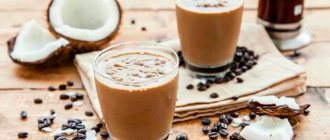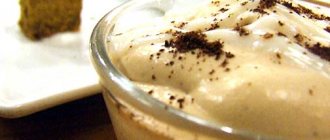General information
Coffee is a noble drink made from roasted and ground coffee beans. In 850 BC. raw grains were taken as an invigorating agent.
Only towards the end of the 17th century. They began to fry them and brew them with boiling water. In the 14th century the tree was brought to the Arabian Peninsula, then spread to the Ottoman Empire, then to Europe and India.
The most common varieties are Robusta and Arabica. They grow in Brazil, Colombia, Ethiopia, Honduras and India. Growing coffee is a costly and labor-intensive process.
The coffee tree needs indirect light, watering, insecticide treatment and weeding. The average fruiting period of a coffee tree is 60-70 years.
Ripe berries are picked by hand by seasonal workers. The harvest is subjected to careful processing: drying, frying and mechanical peeling. There is no uniform classification of coffee, so producing countries are guided by their own requirements.
Ludwig van Beethoven was a lover of strong coffee, who used 60 beans when brewing. The French poet Voltaire was also not inferior to Beethoven in preferences and drank 50 cups of coffee per day.
Other coffee additives
Milk is the most common, but not the only ingredient that can be used in the process of preparing a black drink. Many people add condensed milk, cream, ice cream, and much more. Let's see how many calories they contain and add that data to our calculations. We will take average indicators as a basis.
Chocolate (syrup)
Per 100 grams of product - 149 kcal. A teaspoon - 10 kcal.
Cream 10%
Per 100 grams of product - 100 kcal. A teaspoon - 10 kcal.
Condensed milk
Per 100 grams of product - 295 kcal. A teaspoon - 29 kcal.
Ice cream
Per 100 grams of product - 124.2 kcal. A teaspoon - 12 kcal.
History of the drink
It goes back a long way. The first to notice the invigorating effect of coffee were the people of the Ethiopian Oromo tribe, but there is no evidence to support this theory.
A more plausible version is that the shepherd Kaldim in 850 noticed the invigorating effect of coffee beans. However, this legend also has no substantiated arguments.
Ethiopia is considered the ancestor of coffee, from where the drink first came to Egypt and Yemen, then to the Near and Middle East, and by the end of the 19th century. spread throughout Italy, Indonesia and America.
Initially, in 1200, the drink was prepared in the form of a strong decoction from the shell of coffee beans; over time, they began to be completely roasted. It is unknown who came up with the idea of supplementing coffee with milk.
Properties of the drink components
Natural milk is a liquid with a very complex and rich chemical composition. Many different microelements were found in it - calcium and phosphorus, iodine, zinc, and even selenium. In addition, the product contains vitamin C, retinol, B vitamins. The composition contains fats, proteins (casein) and carbohydrates (milk sugar - lactose).
All these components are beneficial for the human body and are easily absorbed (with rare exceptions).
The composition of coffee beans is also well studied, the most significant of which are:
- caffeine and other alkaloids;
- tannins (tannins);
- potassium;
- tocopherol;
- cellulose;
- iron;
- magnesium;
- vitamin PP.
The debate about the effects of coffee on the body does not subside - ardent opponents consider it almost poisonous, fans consider it extremely beneficial, and both sides have arguments.
It cannot be denied that the drink has a strong effect on the body, and is strictly contraindicated for a number of diseases. It should be avoided if you have stomach, heart, hypertension and some other diseases.
Attention! It makes sense for women who are planning a pregnancy, carrying a child, or breastfeeding to refrain from drinking the drink. Children should not drink it, and older people should be careful.
For those who have no obvious contraindications, a small dose of natural fresh coffee will only bring benefits - after all, it invigorates, improves mood (due to its effect on the production of the hormone serotonin), improves brain activity, and even prevents the development of a number of diseases (bronchial asthma, for example) .
Reasons for adding milk to coffee
Milk improves the taste of coffee and reduces the negative effects of caffeine on the body. It contains essential amino acids and calcium, which is essential for the skeletal and cardiovascular systems.
The drink contains a large amount of vitamins, antioxidants, polyphenols, and a mixture of acids that improve the secretion of gastric juice.
The composition of grains is taken into account when drawing up the menu: everyday irritation of the gastric mucosa with acid causes gastritis. Before drinking coffee, you should have breakfast or a snack. If the pH level of the stomach is elevated and erosions are present, grain consumption should be limited.
Fragrant coffee with milk.
How does milk affect the properties of a grain drink?
Like any food, coffee contains beneficial substances. Some of them are antioxidants, or otherwise called polyphenols.
Swiss specialists from the Nestle Research Center decided to conduct an experiment, the purpose of which was to find out what effect whole milk has on the amount of antioxidants in coffee, and also to determine how well they are absorbed by the human body. The participants in the study were a group of adults who were alternately asked to drink a cup of drink with and without milk.
The results obtained greatly surprised scientists. The presence of milk had absolutely no effect on the amount of antioxidants in the body of study participants. That is, if you add a little milk, it will not affect its benefits in any way.
But doctors have a different opinion on this matter. In addition to nutritional components and antioxidants, the grain drink also contains acids that cause harm to the human mucosa due to the greater production of gastric juice.
Even healthy people should not drink the vigor drink on an empty stomach, since the hydrochloric acid in our stomach can cause serious harm to the mucous membrane. Also, doctors strongly do not recommend drinking coffee with milk for people who have problems with the gastrointestinal tract.
If you still want to drink a strong cup, give preference to coffee with milk rather than black. Milk will provoke an alkaline reaction in the stomach, and the available fat will weaken the acid reaction. In addition, milk will reduce the negative effect of caffeine on blood vessels, so the drink will not provoke significant pressure surges. It is no coincidence that Italians prefer a softer cappuccino in the morning.
You might think that coffee has a positive effect on hypertensive patients. But this is absolutely not true, because milk contains casein.
Casein glue is a glue of natural animal origin. It is one of the most durable. Don't believe me? Try washing a pan that has milk stuck to its walls without using household chemicals. Caffeine in combination with milk forms a substance that is poorly absorbed by our body, and because of which it is problematic for gastric juice to break down this structure, and therefore it remains in the human stomach for a long time.
Approximately the same thing happens on the surface of the walls of blood vessels. The human body lacks enzymes to break down casein. As a result, constipation appears, toxins penetrate into the blood, and rashes are observed on the skin.
With periodic consumption, the human body will easily get rid of such a product. But if drinking is your daily habit, then the possibility of illness increases several times.
Most drinkers believe that milk compensates for the lack of calcium, which is washed out by coffee. This is a strong misconception! The processes of calcium saturation in the human body are very complex. For example, calcium is poorly absorbed if there is a lack of silicon in the body. If you eat a small amount of vegetables that contain silicon, then calcium will not be able to strengthen bone tissue, but will only provoke salt deposition. The older you get, the faster you become depleted of calcium and the more difficult it is to restore calcium balance in your body.
What conclusion can be drawn? Milk reduces the effect of coffee on the gastric mucosa and the cardiovascular system, but, unfortunately, it does not compensate for the lack of calcium in the body. Daily use can cause blockage of blood vessels, gastrointestinal disorders and constant constipation.
Composition and calorie content
According to recent research by scientists, coffee contains more than 1 thousand substances.
Part of them:
- Carbohydrates. They provide the fullness of flavors and create a palette of coffee types. In Arabica this figure is 9%, in Robusta the mark borders between 3 and 7%. When sugar is roasted, some of the organic acids are transformed, which form the final taste of the drink.
- Squirrels. They make up 11-14%. Growing conditions, climate, grain processing methods and variety affect the protein content of the product. When heated, biochemical transformations lead to the formation of new substances responsible for the variety of varieties. For example, ketones and aldehydes give a sweet popcorn flavor, while furans give a sweetness.
- Fats. The level of plant lipids depends on the type of bean and roasting. In Arabica their content reaches 18%, in Robusta - 13%. Heat treatment makes the grains shiny and aromatic.
- Caffeine. The alkaloid gives the drink a characteristic bitter taste and protects the plant from parasites. The invigorating effect is associated with stimulation of the nervous system. A psychostimulant helps overcome fatigue, concentrate attention, and increase mental and physical performance. Doctors recommend taking no more than 0.3 g of caffeine at a time. Side effects may include sleep disturbance, irritability, and increased heart rate.
- Tannin. Gives coffee beans a brown color.
- Vitamins. In the process of frying grains, B vitamins are formed in them, which are necessary to maintain an optimal metabolic level. The product is rich in vitamins A, D, E, which promote the growth and division of body cells, increase immunity and normalize intestinal digestion.
- Minerals. Potassium and magnesium in grains regulate carbohydrate metabolism by producing insulin, which is responsible for the absorption of glucose.
Freshly prepared espresso coffee contains virtually no calories. 100 ml of natural product contains only 2 kcal, espresso - 4 kcal.
The table shows the energy value of 1 serving of some drinks (200 ml):
| Drink | Energy value (kcal) | Proteins (g) | Fat (g) | Carbohydrates (g) |
| Espresso | 19 | 0,2 | 0,4 | 3,3 |
| Cappuccino | 34 | 1,6 | 1,5 | 3,5 |
| Americano | 25 | 1 | 0 | 4 |
| Irish coffee | 416 | 7 | 17 | 60 |
| Latte | 112 | 10,8 | 0,9 | 15 |
| Mocha | 326 | 11 | 15 | 36 |
| Caramel macchiato | 240 | 10 | 7 | 34 |
Calorie content in kcal in a mug of black coffee with and without additives
The fresher the roast, the higher the calorie content of the coffee.
Coffee beans contain sugars and fats, as well as some protein, and if the roast is fresh enough, this will only increase the calorie content. For example, freshly roasted and ground coffee beans without added sugar can provide an increase of 0.5-1 kcal per 200 ml (mug of drink).
The situation with sugar is somewhat different. It all comes down to portions. A teaspoon without a slide accounts for 18-20 kcal, with a larger teaspoon - 26-28 kcal. If you want to add spices to your coffee, keep in mind that even 1 g gives an increase in calorie content:
- dry ginger – 1 kcal/1 g;
- cinnamon – 2.5 kcal/1 g;
- vanilla – 3 kcal/1 g;
- cardamom – 3 kcal/1 g;
- cloves – 3 kcal/1 g;
- pieces of fresh ginger – 3.5 kcal/1 g;
- nutmeg – 5 kcal/1 g.
Types of milk-based coffee
Milk is added in different proportions to freshly brewed coffee with a tart and rich taste. Cappuccino, latte and macchiato are prepared from a mixture of 2 products.
Cappuccino
Appeared back in the 18th century. thanks to the Capuchin monks, whose members wore brick-red robes. In Austria, the drink was prepared from coffee, cream and yolks.
Another version says that the red-orange nasturtium flowers were cup-shaped. However, the official history of cappuccino dates back to the 20th century, when it spread throughout Italy.
Milk and coffee are required for preparation. Arabica or a blend of Arabica and Robusta is suitable. The recommended list includes milk, “Milk River” or Rioba with a fat content of 3.5%. Before frothing milk, it should be cooled to 2-6ºC. If you don't have a coffee machine, it's better to take cream.
Instructions:
- Pour coffee into a warm 200 ml cup;
- froth warm milk (temperature - 60-70ºC) with a cappuccino maker until a strong foam forms;
- Slowly introduce the foam into the coffee base, trying to pour the milk along the side of the cup.
A properly prepared cappuccino is divided into layers. In coffee shops, the finished product is decorated with chocolate and cinnamon, making unusual designs.
Cappuccino with large foam.
Latte
In Spain it is served in small café con leche cups, in France - café au lait. In 1867, the English press mentioned that in coffee shops in Italy travelers were served a drink less strong than cappuccino - latte. Demand for it came in 1980 from people who loved unsaturated grain decoctions.
The preparation of a latte is no different from a cappuccino. The difference lies in the proportions of milk and coffee. You can supplement it with cinnamon, vanilla or chocolate.
Milk with a fat content of 3.5% is difficult to form foam, and a 2% product deprives the latte of a pleasant taste with a creamy tint. It is better to choose a fat content of 2.5-3.2%.
A classic latte is prepared from a mixture of espresso (50 ml) and milk (150 ml). First pour the coffee into a small cup, and then slowly add the frothed milk. An indicator of proper cooking is the formation of foam on top, and both products are mixed.
Macchiato
This is espresso with milk not exceeding 1/2 the volume of coffee. The history of the origin of macchiato begins in 1930 in Italy. Curious Italians had questions about the amount of milk added to coffee.
The baristas called the new drink "macchiato", which translated from their native language means "spotted" (due to the appearance of light spots on the surface).
For preparation you need a mixture of Arabica and 10-15% Robusta. You should not take a lot of robusta, which gives a bitter aftertaste. To fully develop the taste, you should brew the drink in filtered water.
Tap liquid, like boiled liquid, will spoil the taste. Suitable milk fat content is 2.5-3.2%; it can be replaced with baked product. For lactose intolerance, use plant milk.
Macchiato ingredients:
- espresso - 35 ml;
- milk (temperature - 60ºC) - 15 ml.
Freshly brewed coffee is poured into a cup, and milk pre-whipped with a cappuccino maker is poured into it. Next, add cane sugar, a pinch of vanillin, and caramel syrup. For beauty, the foam is sprinkled with chocolate or ground cinnamon.
Caramel macchiato.
Cooking recipes
How to brew coffee with milk, make it quick and tasty? There are several secrets to this delicious drink. Fat milk significantly improves the taste of the product. It gives a soft creamy taste and good foam if the recipe calls for whipping it. There is no need to add sugar. Good grains and milk themselves give the drink a natural sweetness. It is important to follow the preparation recipe: the taste and type of the drink depends on the sequence and how the ingredients are combined.
Classic recipe for coffee with milk
Coffee with milk is brewed in a wide-necked Turk or small saucepan. Pour 150 ml of milk into it, add sugar and spices as desired (cinnamon or cardamom), mix. Pour 1-2 tsp. ground grains, put on fire. It is important not to let the milk escape. The drink is simmered over low heat, skimming periodically to preserve the foam. After infusion, pour into a cup.
The finished drink according to the classic recipe is also called white coffee, since milk completely replaces water in it.
Recipe with baked milk
To make coffee with milk, you can use the classic method, but using baked product. It's a hassle, but worth it. If you have small children at home, you can kill two birds with one stone: prepare baked and easily digestible milk for the child and an excellent addition to coffee for yourself.
Baked milk is cooked in a saucepan over low heat for 3-4 hours, periodically skimming off the foam. The color of the finished product should be caramel.
Coffee drink recipes
Preparation:
- Brew 100 ml of an invigorating drink from 1 tbsp. l. ground grains.
- Let stand for 1 minute.
- Combine with 150 ml of warm baked milk and stir.
- No sugar is added.
The drink has a beautiful color, a very pleasant sweetish aroma and great taste.
Recipe with condensed milk
You can brew coffee in a Turkish coffee pot as usual, in Turkish style, and add condensed milk to the already cold drink to taste. If you add it to a hot drink that is removed from the heat, it can cook and small balls will spoil both the taste and appearance of the product. In addition to condensed milk, coconut milk is sometimes added to coffee. This is an additional ingredient that gives an unusual note to the entire drink. You will never try this in a cafe.
Recipe with milk powder
For travelers or instant coffee lovers, a recipe with milk powder is suitable. It is prepared in advance, poured into a jar and stored like regular 3-in-1 coffee.
Ingredients and proportions:
- 160 g milk powder;
- 130 g powdered sugar;
- 70 g instant coffee;
- 20 g instant cocoa.
All ingredients are mixed. For 1 cup of hot water take 1-2 tsp. mixtures. This homemade mixture can be used as a base for a cocktail or as a quick drink for the road or at the cottage. It is as natural as possible and does not contain preservatives, flavors or other chemicals. Of course, it differs in taste and aroma from classic Turkish coffee with milk, but it is also delicious.
You can make coffee with soy and almond milk. These are unusual and rare drinks that only a few people like, but for general development you can experiment at home. If the recipe uses frothy milk, it is prepared separately from the coffee. First, it is heated to 60°C, then whipped with a whisk or in a cappuccino maker, and then combined with the drink, pouring in a thin stream and spreading the foam with a spoon.
Beneficial features
The Swiss company Nestle conducted research on the effects of milk on human health. It was possible to establish the time during which polyphenols appear in the blood.
The analysis showed that the type of milk does not affect the ability of substances to enter the blood faster. This does not affect the antioxidant capacity.
Experiments have proven that adding a small amount of milk reduces the invigorating effect. Caffeine takes longer to digest, so its effects are longer lasting.
Protection from diseases
The drink contains antioxidants in high doses. They have antibacterial, antiviral and anti-inflammatory effects.
Cappuccino, latte or macchiato lowers blood pressure. Regular consumption of the product in reasonable quantities enhances the body's protective function.
Reducing the risk of cancer
Drinking 1 cup of coffee a day can reduce the risk of liver cancer by 15%. Women are less likely to get breast cancer. Antioxidants prevent premature aging of cells and improve immunity.
Calorie content of coffee (per 100 grams of product)
| Coffee type | Calories, kcal | Squirrels | Fats | Carbohydrates |
| Granular, soluble | 94 | 15 | 3,5 | 0 |
| In beans | 223 | 13,9 | 14,4 | 15,6 |
| Ground | 201 | 13,9 | 14,4 | 4,1 |
So, these are the indicators of the raw materials. Let's calculate the required values.
As you can see from these data, the lowest calorie coffee is granulated (see how freeze-dried coffee is made). Until now, many people continue to drink this drink. On average, take 2 tablespoons of coffee for one 200 ml cup. In our case, one spoon is approximately 8 grams of raw material.
As a result, we get 15 grams for one finished mug.
Conclusion - 1 cup of instant coffee contains about 14 calories
Go ahead. Let's calculate how much energy a mug of drink made from beans or ground coffee will give us.
For calculations, we will again take 2 spoons of raw materials per cup. These indicators are adhered to in most recipes - for Turkish coffee (see Oriental coffee), in coffee machines, etc. Accordingly, we will need 15 grams of coffee. We carry out simple calculations and get the result.
Conclusion.
A cup of whole bean coffee has about 33 calories. A cup of ground coffee - about 30.
You can see other indicators in the table. What can be noted. Natural bean coffee can be safely consumed before sports training (see why it is not recommended to drink a lot of coffee). They contain proteins necessary for muscle growth, as well as carbohydrates that saturate our body with energy. This is a completely acceptable energy drink.
But we completely forgot about sugar. If you add it to a ready-made drink, then add 30-32 calories per spoon. If we add 2 teaspoons to our coffee beans, our drink will end up containing about 100 calories.
Now you have everything you need for the calculation.
Effect on the body
There is a popular belief that coffee is addictive. Many people consider grains to be harmful and avoid them altogether. The effect of an invigorating drink on the body of children, pregnant women and nursing mothers is very different.
Female
Caffeine negatively affects hormonal levels, causing mood swings. If you have diseases of the reproductive system, such as cysts or polycystic ovary syndrome, drinking too much can aggravate the course of the pathology.
When planning a pregnancy, it is better to give up espresso, latte and even cappuccino. Daily consumption of the drink leads to the appearance of bags under the eyes, discoloration of tooth enamel, and swelling.
A cup of coffee in the morning will give you energy for the whole day.
Male
Coffee has both positive and negative effects on men. When drinking 1-2 cups a day, you feel a surge of strength and improve your performance.
A high dosage of caffeine leads to disturbances in the gastrointestinal tract and nervous system. Caffeine greatly affects the functioning of the heart and the condition of blood vessels.
Regular consumption of coffee decoction often causes addiction. Coffee also affects a man’s reproductive ability, which is reflected in a decrease in sperm motility.
The drink improves performance.
In children
Children under 7 years of age are not recommended to drink coffee. As an exception, it is possible to give children over 6 years of age a weak decoction with milk once a month. Often teenagers are addicted to instant drinks or coffee from the machine, and this is not recommended even for adults. If you have acne, you should limit your consumption of types of coffee such as lattes, macchiatos and cappuccinos.
During pregnancy
Pregnant women are allowed to drink latte, macchiato and cappuccino no more than 2 times a month. Coffee changes hormonal levels, which causes mood swings, anxiety, and fatigue.
The drink constricts blood vessels, which disrupts the nutrition of the fetus, and this can lead to asphyxia. Do not forget about the leaching of calcium from the body, which results in rickets.
Coffee can trigger the development of gestosis and nausea. It is strictly forbidden to drink it for the first 4 months after childbirth if a woman is breastfeeding.
Coffee is not recommended for pregnant women.
Verdict: Coffee with milk is not harmful to health
So what is the final conclusion? This is not to say that adding milk or herbal alternatives to coffee is harmful to health. It has been shown that this does not affect the antioxidant activity of coffee beans, but, on the other hand, softens the stimulating effect of caffeine and prolongs it. This combination has never been proven to negatively affect digestion or create harmful substances in the body.
Milk can balance the pH level in the stomach, minimizing the irritating effects of acidic coffee. But it is important to be careful about calories, carbohydrates, fats - in excessive quantities, these food components can cause weight gain.
Possibility of use during diets
The main task of diets is to cleanse the body of toxins and waste, and relieve the burden on the digestive system. To do this, the menu includes light foods that are low in calories.
Coffee without added sweeteners, milk or cream helps in weight loss. Caffeine enhances metabolism, promoting lipolysis of fat deposits.
Sweet latte, cappuccino and macchiato weaken the effect of this substance and neutralize acids. They do not help you get rid of excess weight, but only add kilograms.
Caffeine promotes weight loss.
Contraindications for use and harm to the body
In rare cases, coffee with milk causes lymph stagnation. This is evidenced by swelling, the appearance of flatulence, and specific discharge in women.
Rapid weight gain is a clear sign of problems in the body caused by caffeine. We must not forget about psychological dependence when abusing coffee beans.
The following groups of people should refuse the drink:
- hypertensive patients (vasoconstriction increases blood pressure);
- people suffering from mental illness (caffeine irritates the nervous system, causing rapid heartbeat, anxiety, and panic attacks);
- pregnant and nursing mothers to prevent the development of fetal pathology.
Many people argue about the compatibility of coffee and milk, but this combination allows you to prepare 3 drinks at once: cappuccino, latte and macchiato. Milk weakens the effect of caffeine on the body, giving a delicate taste to the invigorating mixture. If you are lactose intolerant, you may want to try other types of milk.
Can I drink coffee with milk?
The answer to this question depends on the environment in the body, more precisely in some of its organs. As for the stomach, there are no problems here. On the contrary, adding milk to a drink is beneficial for it. Complications can occur in the duodenum, in which, after consuming this combination, smooth muscle contraction begins. These contractions can subsequently affect the pancreas, preventing it from functioning properly. This can lead to blockage of the gallbladder and bile ducts with subsequent digestive problems.
If the gallbladder does not work properly, more serious problems may arise, especially in older age, when a person may be bothered by gallstones, diabetes, joint pain and spinal pain.
Have you heard about Chicory? We have described in detail what this coffee drink is and its health benefits
The fact about the harmful effects of coffee with milk is quickly spreading among people. But even here the world is not black and white. Therefore, the truth about the consumption invigorating drink and its effect on the body is also not monotonous. Many experts are of the opposite opinion. In their opinion, the role is played not by the negative consequences of a combination of 2 products , but by lactose intolerance. For a person suffering from an allergy to this milk component, its consumption has an irritating effect.
Important! Some nutritionists recommend adding milk to coffee for people with stomach problems (in particular, those with ulcers). This way the drink will tone , but not irritate the mucous membranes.
Does the type of milk used matter (low-fat, semi-fat, whole, cream )? It's more a matter of taste . The composition of coffee actually triggers the release of neurotransmitters in the brain, which suppresses anxiety. The man relaxes. But if you have problems with the gallbladder, increased sensitivity to fat is present as such. Therefore, if more than the optimal dose of cream (1 tsp) is consumed , an adverse reaction may occur. However, 80% of the population does not have this problem.











